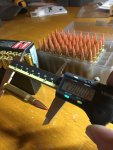A forum member,
@elfster1234, made this 10 video playlist. You dont need to do everything in it such as annealing but it is very comprehensive and a good watch. Youll learn a bunch. (I would rather learn a bunch when youre firing those rounds off 6" in front of your face than wade into it with ignorance)
https://www.youtube.com/playlist?list=PLCyPEnjRX7ebb28MKusD6VfMZlnsNkpK0
But for starters, measuring Over All Lengths will never get you consistent numbers. The only thing you need to worry about OAL for it to make sure it fits in your magazine.
What you want is a measurement down the nose of the bullet right in front of the bearing surface, thats the cylinder portion of the bullet that actually touches the barrel. We care about the interface of the bullet to the barrel, the tip is just floating in space and not that useful. The term for what we are looking for is CBTO, Case Base To Ogive.
View attachment 6981010
The ogive is the entire curvature of the nose of the bullet but what we care about is that part right at .300 for a 308 where the lands will first contact the bullet. When we reloaders say to the ogive that is just slang to that specific point. The bullet first contacts the smaller diameter, the lands, and then is forced into the barrel through pressure engraving itself into them when fired.
View attachment 6981019
You can see here in this image that if you seated these different bullets to the same OAL that the ogive of each particular bullet is in a completely different location. That could lead to you inadvertently jamming your bullets into the lands. That can cause pressure spikes and be bad juju.
View attachment 6981016
So to measure where the bullet is actually touching you are going to want to get a bullet comparator to put on your calipers. This will allow you to measure on a consistent part of the bullet repeatedly.
https://www.midwayusa.com/product/1...ad-bullet-comparator-basic-set-with-6-inserts
View attachment 6981022
And some nice images to look at and study the relationships with
View attachment 6981023
View attachment 6981024
So thats what youre looking at with bullet seating depth. Now, how to actually find that depth. You can use a cleaning rod down the barrel to measure the difference in distance from an empty chamber to a bullet placed in the lands. That will be based off of the over all length of the bullet so there will be some error but its a crude approximations that is much more elegant that just trying to guess at it from a book. At least youll have an actual number instead of an arbitrary one.
View attachment 6981029
You can do much better with a hornady loack and load oal gauge. You seat the bullet deep into a modified case and then push it into the chamber, and then use the internal rod to push the bullet forward to the lands. Extract it when you feel contact and take your measurement.
View attachment 6981030
Finally you can measure it with your actual chamber


